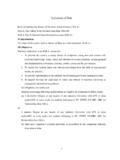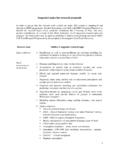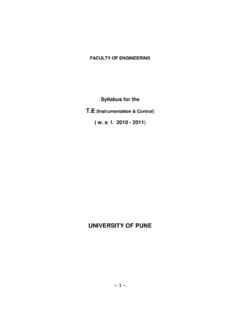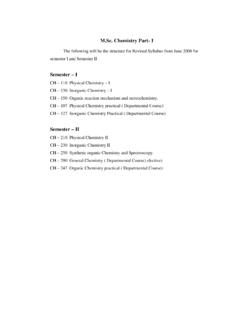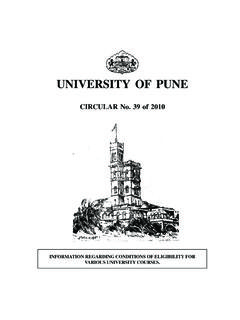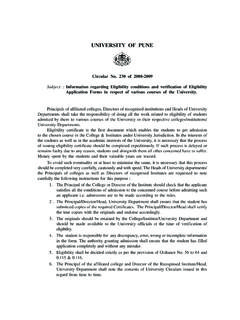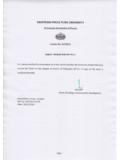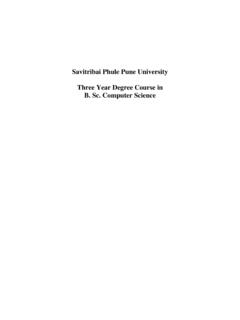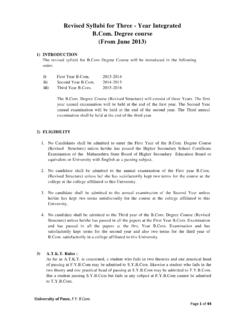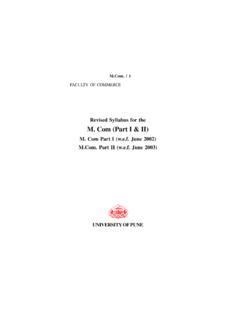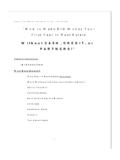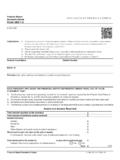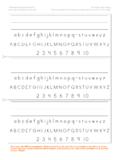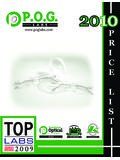Transcription of B.E. (Polymer Engineering) 2008 Course - Official Website.
1 FACULTY OF engineering . Syllabus for the ( polymer engineering ) 2008 Course (w. e. f. 2011-2012). UNIVERSITY OF PUNE. University of Pune Structure of BE polymer engineering ( 2008 ) Course TERM I. Subject Subject Teaching Scheme Examination Scheme Total Code No. Theory Practical Drawing Paper TW Practical Oral 409361 polymer Compounding 4 2 - 100 50 - - 150. 409362 Mold & Die Design-I. 4 - 4 100 25 - 50 175. 409363 polymer Processing Operation II 4 2 - 100 - 50 - 150. 409364 Elective I 4 - - 100 - - - 100. 409365 Elective II 4 - - 100 - - - 100. 409366 Industrial training evaluation - - - - 50 - - 50. 409367 Project - 2 - - - - 25 25. TOTAL 20 6 4 500 125 50 75 750. TERM II. Subject Subject Teaching Scheme Examination Scheme Code No. Total Theory Practical Drawing Paper TW Practical Oral 409368 Product Design &. 4 2 - 100 25 50 - 175. polymer Testing 409369 Mold & Die Design-II. 4 - 4 100 25 - 50 175. 409370 Elective III 4 2 100 50 - - 150.
2 409371 Elective IV 4 - - 100 - - - 100. 409367 Project - 6 - - 100 - 50 150. TOTAL 16 10 4 400 200 50 100 750. List of elective subjects: Subject Subject Code No Elective I Code No Elective II. 409364-A Fiber Technology 409365-A Production Planning and Control 409364-B Mechanics of Composites 409365-B Surface Coatings and Adhesives 409364-C polymer Reaction engineering 409365-C Packaging Technology Subject Subject Code No Elective III Code No Elective IV. 409370-A polymer Physics and Characterization 409371-A Advanced polymer Rheology 409370-B Processing of Composites 409371-B Rubber Technology 409370-C Specialty Polymers & Applications 409371-C polymer Thermodynamics and Bends 409371-D Open*. * Open Elective should be based on any Industry need with prior approval of BOS Chemical engineering Semester I. polymer engineering 409361 : polymer Compounding Teaching scheme: Examination scheme: Lectures: 4 hrs / week Paper: 100 marks Practical: 2 hrs / week : 50 marks Objective To impart the knowledge of compounding and mixing processes for the polymers and to study various mixing devices from the point of view of optimization of mixing time and power consumption.
3 Unit I: polymer Mixing and Blending (8 hrs). Introduction, basic concepts, mechanism of mixing and dispersion, mixing of solid-solid, liquid- liquid and liquids-solids, dispersive mixing, distributive mixing and laminar mixing, mixing entropic measures and its applications, mixing indices, scale of segregation and intensity of segregation, kinetics of mixing, rheology of filled polymers, overview of polymer mixing and blending machinery. Unit II: Compounding (8 hrs). Introduction, types and characteristics of compounds polymer blends, polymer formulations, filled polymers and polymer composites, compounding practice, mixing types, solid additives, morphology of filler additives, filler reinforcement, compatibilizers mechanism and theory, filler surface modification and interfacial agents, dispersion of polymer nanoparticles in polymer melt. Unit III: polymer Compounds (8 hrs). polymer compound ingredients, fillers and reinforcements viz.
4 Carbon black, ZnO, calcium carbonate, titanium oxide, nano clay, glass fibers, organic fillers, nanofillers, processing aids, flame retardants etc., studies of polymer compound properties, multi-component compounds, compounding of polyolefins, polystyrene and styrene copolymers, engineering polymers, wood floor and natural fiber filled plastics, compounding lines, post compounding operations. Section II. Unit IV: Mixing and Compounding Applications (8 hrs). Introduction, additives used for plastics, inorganic filler compounding, glass fiber compounding, nano-composite compounding, reactive extrusion, recycling applications, reactive compounding, free radical grafting of monomers onto polymers, reactive blending, elastomer compounding (NR, SBR, BR, IR, EPDM etc.), compounding materials used for unsaturated polyester, polyvinyl chloride, etc. mixing and compounding of PVC, compounding practices for other polymers, compounding for cable and profile extrusions, compounding economics.
5 Unit V: Mixing Machinery and Devices (8 hrs). Batch and internal mixers, single screw extruder, kneaders, modular co-rotating and counter- rotating twin screw extruders, continuous mixers, co-kneader, mixing mechanisms in kneader, modeling of kneader, residence time distribution, feeding and feeder, distributive mixing sections, cavity mixers, pin mixers, slotted fight mixers, variable depth mixers, dispersive mixing, blister ring, fluted mixing section, planetary gear mixers, CRD mixers. Unit VI: Compounding Machinery and Devices (8 hrs). Two roll mills: Design features, speeds & friction ratios, sizes & capacities, mixing action, strip cutting, cross mixing devices. Internal mixers: Design features, rotor designs, control. Single screw compounding machine: Two section screws, smear heads, screws with kneaders, shear cone units, barrels with internal projections. Twin screw extruders: tapered screws in feed zone, internal mixer zones, continuous internal mixer.
6 Intermeshing Corotating, Corotating geometry, conveying characteristics of screw elements & mixing elements, metering zone, leakage flow equations, solids conveying zone, melting mechanism, residence time distribution, miscellaneous continuous compounding machinery, safety precautions, List of Experiments (any 8). 1. To study the functioning of two roll mill. 2. To study Banbury mixer. 3. Mixing characteristics of sigma mixer and preparation of Dough Molding Composition formulations using sigma mixer. 4. Preparation of plasticized polyvinyl chloride (PVC) compound using two roll mill. 5. Preparation of phenolic molding compound using two roll mill. 6. To study the mixing time for compounding of plasticized PVC compositions by using Brabander. 7. To study the torque and mixing time for compounding of filled (Talc and CaCO3). polypropylene compositions. 8. Preparation of plasticized PVC compound using single screw extruder.
7 9. Preparation of filled polymers using twin screw extruder. 10. To study power consumption for twin screw compounder. 11. Preparation of master batch for PVC based cable application. 12. To study compounding and dispersion of carbon black filled compositions. Reference Books: 1. Unit operations in Chemical engineering , Mccabe ,Smith & Harriot, McGraw Hill, 1993. 2. "Mixing in polymer processing "- Edited by Chris Rawendaal, Marcel Dekker. 3. Principles of polymer Processing , Second Ed., Z. Tadmor, Gogos, Wiley- Interscience, 2006. 4. Advanced polymer processing operations , edited by Nicholas P. Cheremisinoff, Noyes publications, 1998. 5. " polymer mixing and extrusion" , Nicholas Cheremisinoff, Marcel Dekker,1998. 6. " polymer mixing technology", George Mathews , Applied science, London,1984. 7. Plastics Materials , J. A. Brydson, Jordon Hill, Oxford, 1999. 8. polymer Mixing Technology and engineering , White, Coran and A.
8 Moet, HanserGardner Publications Ltd., USA, 2001. 9. Rubber Technology Compounding and Testing for Performance, Ed. J. S. Dick, HanserGardner Publications Ltd., USA, 2001. 10. Thermoplastic and Rubber Compounds Technology and Physical Chemistry, White, K.. J. Kim, HanserGardner Publications Ltd., USA, 2007. 11. Mixing and Compounding of polymer Theory and Practice, 2nd Ed., I. M. Zloczwero, Hanser publications, 2009. 12. Understanding Compounding, R. H. Wildi and C. Maier, HanserGardner Publications Ltd., USA, 1998. 409362: Mold and Die Design -I. Teaching scheme: Examination scheme: Lectures: 4 hrs/week Paper: 100 marks / 4 hrs Drawing: 4 hrs/week TW: 25 marks Oral: 50 marks Objective: To impart the knowledge of injection mold and extrusion die design so that when the students join the industry, they are fully acquainted with design aspects like design calculations, assembly, detailing of molds as well as mold materials and manufacturing aspects.
9 Section I. Unit I: Ejection and Cooling System (8 hrs). Ejection system: Constructional features of ejector grid, ejector grid layout, types of ejector elements pin ejectors, sleeve ejectors, valve ejectors, D-pin ejectors; stripper plate ejection technique; types of sprue pullers, calculation for ejector force. Cooling system: Bolster cooling systems, insert cooling systems, baffle, bubbler cooling systems, heat rod and heat pipe systems, cooling time calculation, cooling channel layout. Unit II: Two Plate and Underfed Mould (8 hrs). Design and constructional features of two plate molds, design and constructional underfed molds. Unit III: Die Design (8 hrs). Extrusion die design: Basic considerations in die design, constructional features of rod die, constructional features of in-line pipe die, cross-head pipe die, offset pipe die, constructional features of centre-fed blown film die, side-fed blown film die, spiral mandrel blown film die.
10 Section II. Unit IV: Heat Treatment and Finishing Operations (8 hrs). Basic tools and die materials, BIS and other major coding systems, materials and heat treatments, effect of alloying elements on steel, various heat treatments like annealing, normalizing, hardening, tempering, surface hardening like carburizing, nitriding, cyaniding, carbo-nitriding etc., cutting tool geometry, mold fabrication techniques like spark erosion, milling, finishing operations like grinding, polishing, honing, buffing, lapping, super finishing, depth of cut and power required for machining, costing of molds and mold maintenance. Unit V: Metrology (8 hrs). Measurement of straightness, flatness, squareness, parallelism, circularity and rotation;. measurement of surface finish, surface roughness as per Indian Standard, metrology of screw threads, terminology, measurement of various elements of thread, limits, fits and gauges, guide for selection of fits, ISO system of limits and fits, tolerance, positional tolerance, geometric dimensioning and tolerance, geometric characteristics and symbols.
